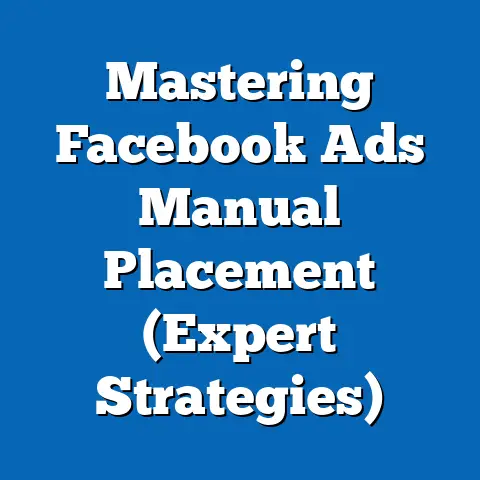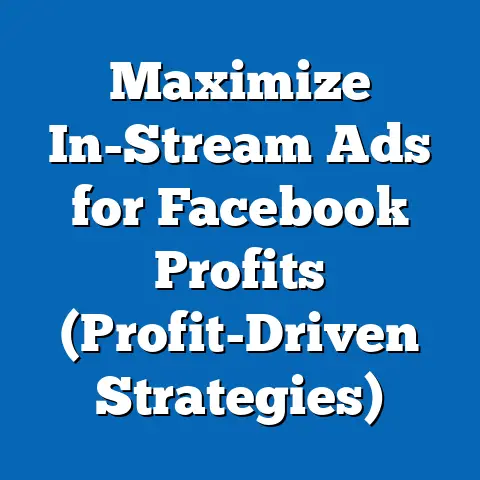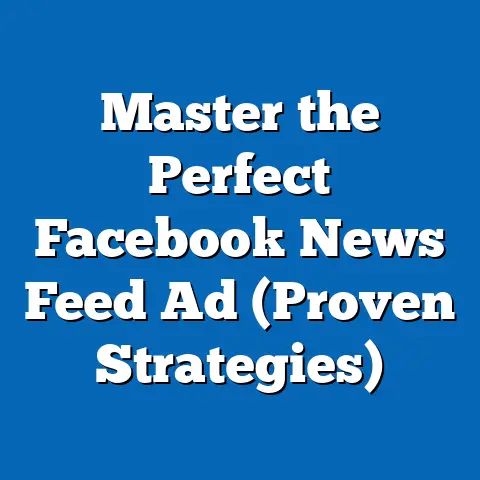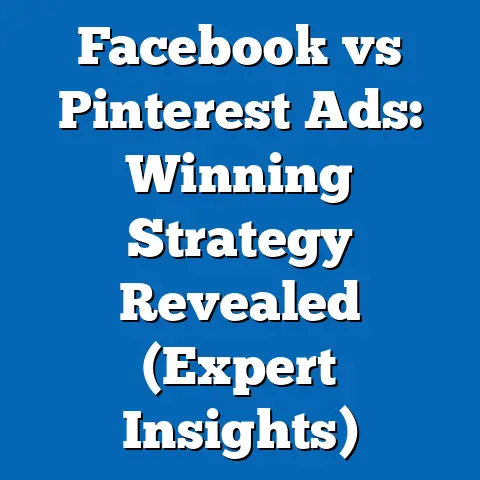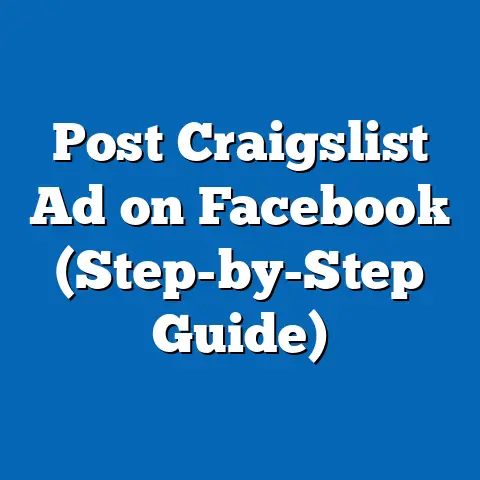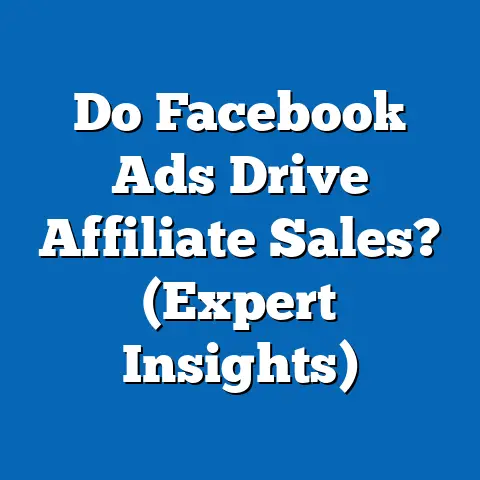Master Pending Facebook Ads (Unlock Campaign Success)
Have you ever launched a Facebook ad campaign only to see mediocre results that leave you questioning your strategy? You’re not alone. With over 2.9 billion monthly active users, Facebook’s advertising platform offers immense potential, yet countless businesses struggle to unlock its full capabilities. As more advertisers flood the platform, standing out becomes increasingly difficult. It’s easy to feel overwhelmed by the myriad of options, algorithms, and ever-changing best practices. How can you turn your pending Facebook ads into powerful tools that drive engagement and conversions? In this article, we will explore actionable strategies that can transform your ad campaigns from ‘pending’ to ‘successful,’ ensuring you not only reach your target audience but also convert them into loyal customers.
Understanding the Facebook Ads Ecosystem
Before diving into the nitty-gritty of ad creation and optimization, it’s crucial to understand the Facebook Ads ecosystem. Think of it as a living, breathing organism with various interconnected parts, each playing a vital role in the overall health and success of your campaigns. This ecosystem encompasses everything from ad formats and placements to audience targeting and the ever-mysterious Facebook algorithm.
I remember when I first started running Facebook ads, I felt like I was throwing spaghetti at the wall and hoping something would stick. I didn’t truly understand how all the pieces fit together, and my results were… less than stellar. It wasn’t until I took the time to learn the fundamentals that I started seeing real progress.
Key Components of the Facebook Ads Ecosystem:
- Ad Formats: From single image ads to video ads, carousel ads, and collection ads, Facebook offers a variety of formats to suit different objectives and creative styles.
- Ad Placements: Where your ad appears – Facebook feed, Instagram feed, Messenger, Audience Network – significantly impacts its performance.
- Audience Targeting: The ability to target specific demographics, interests, behaviors, and connections is what makes Facebook advertising so powerful.
- Facebook Ads Manager: The central hub for creating, managing, and analyzing your ad campaigns.
- Facebook Pixel: A snippet of code that tracks website visitors and actions, allowing you to retarget them with relevant ads and measure conversions.
- Facebook Algorithm: The invisible force that determines which ads are shown to which users, based on a complex set of factors like relevance, engagement, and bid amount.
Navigating the Facebook Ads Manager Effectively:
The Facebook Ads Manager can seem daunting at first, but it’s your best friend when it comes to running successful campaigns. Take the time to familiarize yourself with its different sections:
- Campaigns: Where you set your campaign objective (e.g., awareness, traffic, conversions).
- Ad Sets: Where you define your target audience, budget, and ad placements.
- Ads: Where you create your ad creative (visuals and copy).
- Reporting: Where you analyze your campaign performance and identify areas for improvement.
I’ve found that the best way to learn the Ads Manager is to simply dive in and start experimenting. Don’t be afraid to click around, explore different options, and see how things work. There are plenty of helpful tutorials and resources available online if you get stuck.
Understanding the Facebook Algorithm:
The Facebook algorithm is constantly evolving, but its core principle remains the same: to show users content that they find relevant and engaging. This means that your ads need to be high-quality, targeted to the right audience, and offer something of value.
Here are a few key factors that influence the algorithm:
- Relevance Score: A measure of how relevant your ad is to your target audience. The higher the score, the more likely your ad is to be shown.
- Engagement Rate: How people are interacting with your ad (e.g., likes, comments, shares, clicks).
- Bid Amount: How much you’re willing to pay for each click or impression.
- Estimated Action Rate: Facebook’s prediction of how likely people are to take your desired action (e.g., purchase, sign up).
Takeaway: Understanding the Facebook Ads ecosystem is the foundation for successful campaigns. Take the time to learn the different components and how they work together.
Setting Clear Objectives for Your Campaigns
Imagine setting off on a road trip without a destination in mind. You might enjoy the scenery along the way, but you’re unlikely to reach any specific goal. The same principle applies to Facebook advertising. Without clear and measurable objectives, your campaigns will lack focus and direction, making it difficult to achieve meaningful results.
I’ve seen countless businesses launch Facebook ad campaigns without a clear understanding of what they want to achieve. They might say something vague like, “We want to get more sales,” but that’s not specific enough. A well-defined objective should be SMART: Specific, Measurable, Achievable, Relevant, and Time-bound.
The Three Main Campaign Objectives:
Facebook organizes campaign objectives into three broad categories:
- Awareness: Focuses on reaching a broad audience and increasing brand recognition.
- Example: “Increase brand awareness among women aged 25-34 in the United States by 20% in the next three months.”
- Consideration: Aims to drive traffic, engagement, and interest in your products or services.
- Example: “Increase website traffic from Facebook ads by 15% in the next month.”
- Conversion: Designed to generate leads, sales, and other desired actions.
- Example: “Increase online sales of our new product line by 10% in the next two months.”
- Example: “Increase brand awareness among women aged 25-34 in the United States by 20% in the next three months.”
- Example: “Increase website traffic from Facebook ads by 15% in the next month.”
- Example: “Increase online sales of our new product line by 10% in the next two months.”
Examples of Specific Objectives:
- Increase Brand Awareness: Reach a new audience with your brand messaging.
- Drive Website Traffic: Send people from Facebook to your website.
- Generate Leads: Collect contact information from potential customers.
- Increase App Installs: Encourage people to download your mobile app.
- Boost Engagement: Get more likes, comments, and shares on your posts.
- Drive Sales: Sell your products or services online.
Aligning Objectives with Business Goals:
Your Facebook ad objectives should always be aligned with your overall business goals. For example, if your business goal is to increase revenue, your Facebook ad objective might be to drive sales. If your business goal is to build brand awareness, your Facebook ad objective might be to reach a new audience.
I once worked with a client who was launching a new product. Their business goal was to generate as much buzz and excitement as possible leading up to the launch. We decided to focus on an awareness objective, creating a series of engaging video ads that showcased the product’s unique features and benefits. The campaign was a huge success, generating a ton of social media buzz and driving a surge of traffic to their website on launch day.
Takeaway: Setting clear and measurable objectives is essential for creating focused and effective Facebook ad campaigns. Align your objectives with your business goals to maximize your return on investment.
Crafting Compelling Ad Creative
In the crowded landscape of Facebook, your ad creative is what grabs people’s attention and makes them stop scrolling. It’s your opportunity to tell a story, showcase your brand, and persuade people to take action. But with so much competition, how do you create ad creative that truly stands out?
I’ve learned that successful ad creative is a combination of eye-catching visuals, persuasive copy, and a clear call-to-action (CTA). It’s about understanding your target audience, knowing what motivates them, and crafting a message that resonates with their needs and desires.
The Elements of Successful Ad Creative:
- Visuals: High-quality images and videos are essential for capturing attention. Use visuals that are relevant to your message, visually appealing, and optimized for mobile viewing.
- Copy: Your ad copy should be concise, compelling, and relevant to your target audience. Highlight the benefits of your product or service, and use language that resonates with their needs and desires.
- Call-to-Action (CTA): A clear and concise CTA tells people what you want them to do next. Use action-oriented language like “Shop Now,” “Learn More,” or “Sign Up Today.”
Tips for Creating Eye-Catching Graphics:
- Use High-Quality Images: Avoid blurry or pixelated images. Use professional-quality photos or videos that are visually appealing and relevant to your message.
- Keep it Simple: Avoid clutter and distractions. Focus on one or two key elements that will grab people’s attention.
- Use Colors Strategically: Use colors that are consistent with your brand and that evoke the desired emotions.
- Optimize for Mobile: Most people will see your ads on their mobile devices, so make sure your visuals are optimized for mobile viewing.
Tips for Writing Persuasive Copy:
- Know Your Audience: Understand their needs, desires, and pain points.
- Highlight the Benefits: Focus on what your product or service can do for them, rather than just listing features.
- Use Strong Headlines: Your headline is the first thing people will see, so make it count. Use strong, attention-grabbing headlines that pique their interest.
- Keep it Concise: People have short attention spans, so get to the point quickly.
- Use a Clear Call-to-Action: Tell people exactly what you want them to do next.
The Power of A/B Testing:
A/B testing is a powerful technique for optimizing your ad creative. It involves creating two or more versions of your ad with slight variations and then testing them against each other to see which one performs best.
I always recommend A/B testing different headlines, images, and CTAs to see what resonates most with your target audience. You might be surprised at the results. Sometimes the smallest changes can have a big impact on your ad performance.
Takeaway: Compelling ad creative is essential for capturing attention and driving results on Facebook. Focus on creating eye-catching visuals, persuasive copy, and a clear call-to-action. Use A/B testing to optimize your creative and maximize your impact.
Targeting the Right Audience
You can have the most beautifully designed ad in the world, but if it’s shown to the wrong people, it’s like shouting into the void. That’s why audience targeting is so critical to the success of your Facebook ad campaigns. It’s about identifying the specific demographics, interests, behaviors, and connections that make up your ideal customer and then targeting your ads to those individuals.
I’ve found that the more precise and targeted your audience, the more effective your ads will be. This is because your ads will be more relevant to the people who see them, which will increase engagement and drive better results.
Facebook’s Audience Targeting Options:
Facebook offers a wide range of audience targeting options, including:
- Demographic Targeting: Target people based on age, gender, location, education, job title, and other demographic factors.
- Interest-Based Targeting: Target people based on their interests, hobbies, and the pages they like on Facebook.
- Behavioral Targeting: Target people based on their online behavior, such as purchase history, website visits, and app usage.
- Custom Audiences: Upload your own customer lists to create custom audiences for retargeting or lookalike targeting.
- Lookalike Audiences: Create new audiences that are similar to your existing customers or website visitors.
Leveraging Facebook’s Audience Insights Tool:
Facebook’s Audience Insights tool is a powerful resource for learning more about your target market. It allows you to explore the demographics, interests, and behaviors of people on Facebook, which can help you refine your targeting and create more relevant ads.
I often use Audience Insights to discover new interests and behaviors that I hadn’t considered before. It’s also a great way to validate my assumptions about my target audience and ensure that I’m targeting the right people.
Strategies for Refining and Segmenting Your Audience:
- Layer Targeting Options: Combine different targeting options to create a more specific audience. For example, you could target women aged 25-34 who are interested in yoga and live in New York City.
- Exclude Audiences: Exclude certain audiences from your targeting to avoid showing your ads to people who are not likely to be interested. For example, you could exclude people who have already purchased your product.
- Create Multiple Ad Sets: Create separate ad sets for different segments of your target audience. This allows you to tailor your ads to the specific needs and interests of each segment.
Takeaway: Targeting the right audience is essential for maximizing the relevance and engagement of your Facebook ads. Use Facebook’s audience targeting options and Audience Insights tool to refine your targeting and create more effective campaigns.
Monitoring and Analyzing Campaign Performance
Launching your Facebook ad campaign is only half the battle. The real magic happens when you start monitoring and analyzing your campaign performance. This is where you gather data, identify trends, and make informed adjustments to optimize your results.
I’ve learned that successful Facebook advertising is an ongoing process of testing, learning, and iterating. It’s about constantly analyzing your data, identifying what’s working and what’s not, and making adjustments to improve your performance.
Key Performance Indicators (KPIs) to Track:
- Impressions: The number of times your ad was shown.
- Reach: The number of unique people who saw your ad.
- Click-Through Rate (CTR): The percentage of people who clicked on your ad after seeing it. A higher CTR indicates that your ad is relevant and engaging to your target audience.
- Cost Per Click (CPC): The average cost you pay for each click on your ad.
- Conversion Rate: The percentage of people who took your desired action (e.g., purchase, sign up) after clicking on your ad.
- Cost Per Conversion (CPC): The average cost you pay for each conversion.
- Return on Ad Spend (ROAS): The amount of revenue you generate for every dollar you spend on advertising.
Using Facebook Ads Manager’s Reporting Features:
Facebook Ads Manager provides a wealth of reporting features that allow you to track your campaign performance in detail. You can customize your reports to show the metrics that matter most to you, and you can segment your data by demographics, placements, and other factors.
I always recommend setting up custom reports that track the KPIs that are most relevant to your campaign objectives. This will help you quickly identify areas for improvement and make informed adjustments to your strategy.
Analyzing Performance Data and Making Adjustments:
- Identify Underperforming Ads: Look for ads with low CTRs, high CPCs, or low conversion rates.
- Test Different Creative: Experiment with different headlines, images, and CTAs to see what resonates most with your target audience.
- Refine Your Targeting: Adjust your targeting options to reach a more relevant audience.
- Optimize Your Bids: Adjust your bids to ensure that you’re getting the best possible value for your advertising spend.
- Pause or Delete Underperforming Ads: Don’t be afraid to pause or delete ads that are not performing well.
Takeaway: Monitoring and analyzing your campaign performance is essential for optimizing your results. Track the KPIs that matter most to you, use Facebook Ads Manager’s reporting features to analyze your data, and make informed adjustments to your strategy.
Continuous Learning and Adapting
The world of Facebook advertising is constantly evolving. New features are introduced, algorithms are updated, and best practices change over time. To stay ahead of the curve and maintain a competitive edge, it’s crucial to embrace continuous learning and adapt your strategies accordingly.
I’ve found that the most successful Facebook advertisers are those who are constantly learning and experimenting. They’re not afraid to try new things, test different approaches, and adapt their strategies based on the latest trends and best practices.
Staying Updated with Facebook’s Advertising Policies and Algorithm Changes:
Facebook regularly updates its advertising policies and algorithms. It’s important to stay informed about these changes to ensure that your ads are compliant and that you’re maximizing your performance.
I recommend subscribing to Facebook’s advertising blog and following industry experts on social media to stay up-to-date on the latest news and trends.
Engaging with Industry Resources, Forums, and Webinars:
There are many valuable resources available online to help you learn more about Facebook advertising. These include industry blogs, forums, webinars, and online courses.
I’ve found that engaging with these resources can be a great way to learn from other advertisers, share your own experiences, and stay informed about the latest best practices.
Learning from Past Campaigns:
Every Facebook ad campaign provides an opportunity to learn and improve. Analyze your past campaigns, both successes and failures, to identify what worked and what didn’t. Use these insights to refine your future strategies and create more effective campaigns.
I always take the time to conduct a post-campaign analysis, reviewing the data, identifying key learnings, and documenting my findings. This helps me to build a knowledge base that I can draw upon for future campaigns.
Takeaway: Continuous learning and adapting are essential for success in the ever-changing world of Facebook advertising. Stay updated with the latest policies and algorithms, engage with industry resources, and learn from your past campaigns.
Conclusion
We began this journey with a challenge: transforming pending Facebook ads into powerful tools that drive engagement and conversions. I hope that through this guide, I’ve equipped you with the knowledge and strategies to do just that. Remember, mastering Facebook ads is an ongoing journey that requires dedication, creativity, and adaptability. By understanding the ecosystem, setting clear objectives, crafting compelling creative, targeting the right audience, and continuously monitoring and adapting, you can unlock the full potential of Facebook advertising for your business growth. Now, take the first step towards mastering your Facebook ads today!

